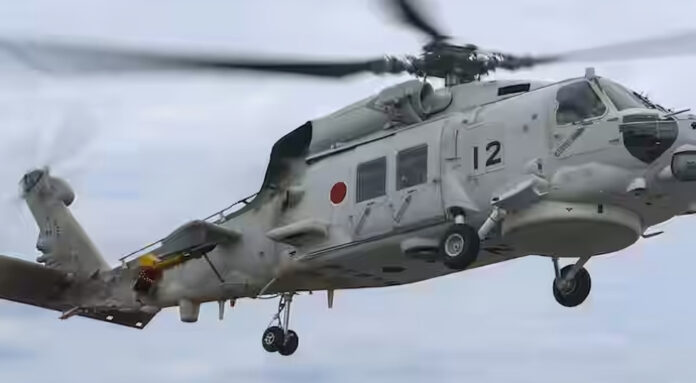A frantic search recovering only debris and a single fatality so far has left Japan’s military steeped in anguish after two maritime patrol helicopters were involved in an apparent nighttime collision over the Pacific. At least seven airmen remained missing Sunday as the harrowing search intensified.
The unfolding tragedy has sent shockwaves through the Japan Self-Defense Forces following the puzzling loss of the two Mitsubishi SH-60K anti-submarine warfare helicopters late Saturday night. The circumstances that led the aircraft to go down near uninhabited Torishima Island, some 600 kilometers off the southern coast, remained murky.
“We retrieved flight recorders and are analyzing the cause, including the strong possibility of a mid-air collision between the two helicopters,” a grim-faced Defense Minister Minoru Kihara told reporters, hardly able to mask his dismay over the inexplicable accident.
The first sign of immense distress arrived around 10:38 pm local time when communications were abruptly severed with one of the helicopters. An ominous emergency signal from that aircraft reverberated through maritime operation centers just a minute later.
While those tense first moments provided a glimmer of hope the stricken chopper may have intentionally ditched, rescuers pulling a lone survivor from the Pacific’s choppy swells watched that fragile optimism evaporate. The airman, Despite frantic life-saving efforts, was pronounced dead after being recovered.
Any sense of relief over finding that initial survivor was fleeting. Roughly 25 minutes after losing contact with the first helicopter, a second SH-60K operating closely with the initial aircraft also stopped communicating from the same coordinates.
The disastrous scenario confronting Japanese authorities soared to unimaginable levels – two helicopters stunningly down within a half-hour period under undetermined circumstances. And now at least seven crew members somewhere adrift at sea as darkness enveloped the remote region.
“At this point the cause is unknown, but firstly we do our utmost to save lives,” Kihara resolutely stated as an extensive air-and-sea search mobilized. Every available maritime patrol asset scrambled toward the ill-fated helicopters’ last known operating area around Torishima.
The desolate volcanic islet, perpetually off-limits due to its rokky terrain and scarcity of level ground, represented the only possible location to seek refuge had the aircrews ditched safely. But approaching darkness and 3-meter swells drastically dimmed hopes.
Somewhere families of the missing aviators began receiving the numbing word that their loved ones were unaccounted for in a Pacific mishap of still undetermined magnitude. As Sunday dawned with no sign of additional survivors, the emotional toll mounted.
The veteran SH-60Ks had been attached to maritime units tracking undersea movements in a region on perpetual watch for Chinese submarine activity. While the reasons for their specific nighttime mission remained undisclosed, Kihara allowed they were likely “doing drills to counter submarines” when whatever went awry.
As anguished search crews feverishly scoured from above and below, the remoteness of the region severely complicated efforts. No other aircraft or vessels were known to be operating nearby when the helicopters encountered their ill fate.
With resources and daylight fading, Japan’s defense forces clung to faint hopes that modernized survival gear afforded the missing airmen at least a chance of being located soon. The maritime workhorses are equipped with life rafts and locator beacons designed to sustain crews in the most hostile environments.
Yet the passage of time continued depleting those narrow odds. And grim memories resurfaced of past military tragedies where something inexplicable went wrong in the Pacific’s vast, utterless openness.
Just a year prior, all 10 airmen aboard an army helicopter died when it crashed at night off Okinawa during a training exercise. There were no survivors.
In 2022, a Japanese fighter jet also plummeted into the sea off central Ishikawa region, killing two pilots. And in 2019, the catastrophic loss of an F-35A stealth jet claimed a pilot’s life after he became spatially disoriented on a training run.
Each incident sparking greater alarm over whether proper protocols and precautions are in place to ensure the ultimate safety of Japan’s rapidly modernizing military air fleet. An alarming string of failures that have already threatened to tarnish the international standing of the country’s aerospace forces.
As Sunday evening’s fading light necessitated a pause in air search operations, the severity of Japan’s latest aviation crisis remained excruciatingly fluid. Airborne crews could only hope that any clues as to the helicopters’ fates would materialized come daybreak.
What is known however, is that the dueling mysteries have inflicted immeasurable pain on a nation still uncertain how many of its selfless service members may never be coming home. For the untold sacrifices rendered in protection of the island nation remain incalculable.























